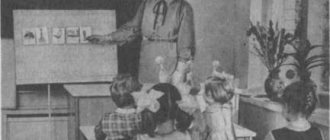Development of phonemic functions as a necessary condition for successful learning at school
Dear friends, we are pleased to introduce you to Fomina Tatyana Gennadievna, a speech therapist at GBDOU kindergarten No. 53 in the Kalininsky district of St. Petersburg. Today Tatyana Gennadievna is happy to share with us her professional experience in the development of phonemic functions, as a necessary condition for successful learning at school. The article will be of interest to teachers and interested parents.
A short commentary on the article from Tatyana Gennadievna:
“The article presents games and tasks for the development of phonemic functions using the example of learning the sound [K]. This material can be used by speech therapists to prevent acoustic dysgraphia. It has theoretical and practical significance, therefore it can be used in training students in the speech therapy departments of the institute. Working according to the system outlined in the article, by the end of the preparatory group, children will master all forms of phonemic analysis, which allows them to study successfully in primary school.”
Useful reading...
The development of phonemic functions as a necessary condition for successful learning at school.
View the article in full version.
Every year in primary school the number of children who fail in the Russian language increases. The most common disorder is acoustic dysgraphia, which in turn is associated with underdevelopment of auditory differentiation. Based on this, it is clear that for children to successfully learn to read and write, well-developed phonemic processes are necessary. Indeed, only if there is a clear image of sound, which is not mixed either auditorily or articulatorily, is it possible to learn to read and write. The question of teaching literacy has been raised a long time ago. K.D. Ushinsky pointed out that before introducing a child to letters, it is necessary to develop “a child’s hearing.”
D.B. Elkonin in the article “Some issues of literacy acquisition” by Fr. He further said: “The subject of a child’s activity when teaching him to read is not the letter, but the sounds of the language!”
At the initial stages of teaching literacy, L.N. Tolstoy suggested not the names of letters, but the names of sounds, and carried out this work by ear, without first memorizing the names of the letters.
Among modern scientists, the same question was posed very sharply by I.N. Shaposhnikov, who wrote: “An illiterate person begins to read (pronouncing a syllable together, without “infection of warehouses”) when he hears and distinguishes individual sounds in speech and, of course, knows their letter correspondence".
History of the study of phonetics.
For a long time (until about 1928), scientists believed that the sound side of speech consists only of a number of elements and combinations. Old phonetics relied on the physiological nature of speech, on articulation. The development of speech was viewed through the prism of the development of motor skills and fine articulatory movements. The development of motor skills was considered the only source of development of the sound side of speech. No one paid attention to the importance of speech perception.
L.S. Vygotsky first drew attention to this. He was the first to introduce the concept of “Phoneme”: he proved that the unit of development of children's speech is the phoneme. From the point of view of this new phonetics, the development of children's speech occurs through the development of a system of phonemes, and not through the accumulation of individual sounds. He said that a phoneme is not just a sound, but a meaningful sound that distinguishes meaning. L.S. Vygotsky was the first to pay attention to the perception of phonemes. He believed that “mastery of a phoneme occurs in conditions of perception of other phonemes and in relation to them. The basic law of perception of phonemes - the law of perception of the sounding side of speech - is the perception of something against the background of something. Every phoneme is perceived and reproduced as a phoneme against a background of phonemes, i.e. phoneme perception occurs only against the background of human speech.
L.S. Vygotsky first introduced the term “phonemic hearing,” which includes 3 speech operations:
- the ability to hear: whether a given sound is in a word or not;
- the ability to distinguish words that contain the same phonemes arranged in different sequences;
- the ability to distinguish words that sound similar but have different meanings.
Somewhat later, D.B. Elkonin introduced the term “phonemic perception.” This scientist was searching for the most effective methods of teaching reading and writing. He drew attention to the fact that to master these skills, phonemic hearing alone is not enough; children need to be specially trained in phonemic perception, which includes 3 operations:
1. The ability to determine the linear sequence of sounds in a word.
2. The ability to determine the position of a sound in a word in relation to its beginning, middle or end.
3.Ability to count the number of sounds in a word.
Later D.B. Elkonin identified phonemic analysis from phonemic perception, including:
1. Finding out the order of phonemes in a word.
2. Establishment of the various functions of phonemes.
3. Identification of the main phonemic oppositions characteristic of a given language.
It was this scientist who proved that before teaching a child to write, it is necessary to teach him the skills of phonemic analysis. In addition, it is necessary to note the role
N.Kh. Shvachkin, who experimentally established the sequence of children’s acquisition of phonemic distinctions. He conducted the following experiments with one-year-old children at the stage of transition from babbling to verbal speech. The child was shown and given some objects to play with and told their fictitious names. Words were selected so that they differed in one phoneme or the presence (absence) of a phoneme: bak - ak, buk - bak, etc. The experimenter ensured that the child learned the correlation of the sound complex with the object, and then asked to show or give the tank, ak, etc. Thus, important patterns of phoneme perception were revealed.
Many scientists, in particular A.R. Luria, tried to answer the question, thanks to which parts of the central nervous system, thanks to which mechanisms of its functioning, the process of speech perception, in particular phonemes, is carried out. A.R. Luria established the development of the corresponding brain structures at different age stages. Already in 1874, E. Wernicke established that there is a sensory speech zone in the cerebral cortex. When it is damaged, a person hears words, but does not understand their meaning, since sound images of words are stored in it.
Thanks to these scientists, as well as many others (S.N. Tseitlin, V.I. Beltyukov, A.D. Salakhova, A.N. Gvozdev), today we have scientific knowledge about the emergence, development, and functioning of phonemic processes.
Terminology.
Today in science there is an acute problem of inaccurate terminology. Different scientists in their works use different terms to denote the same concept. This also applies to phonemic processes, so we need to immediately determine what we mean by them.
The concept of “phonemic hearing” differs in the definitions of the two authors.
L.S. Volkova reveals this concept as follows: “...a subtle, systematized hearing that has the ability to carry out operations of discrimination and recognition of phonemes that make up the sound shell of a word.”
The dictionary edited by V.I. Seliverstov gives the following definition: “Phonological hearing is a person’s ability to analyze and synthesize speech sounds, i.e. hearing, which provides the perception of phonemes of a given language.” This definition rather refers to the term “phonemic perception,” and Volkova’s term more accurately reveals the content of this concept.
Next, you need to define what phonemic awareness is. This term is most fully disclosed in “Speech Therapy” edited by L.S. Volkova, where it is defined as follows: “special mental actions to differentiate phonemes and establish the sound structure of a word.” This definition covers both phoneme discrimination and phonemic analysis, synthesis and representation, i.e. everything that is included in the structure of phonemic perception.
Now let's move on to the definitions of these concepts. In the same textbook L.S. Volkova defines the terms phonemic analysis and synthesis together as “mental actions to analyze and synthesize the sound structure of a word.” This definition does not fully reveal the essence of these processes.
G.G. Misarenko understands phonemic analysis as “the operation of decomposing a word into a successive series of sounds, their classification.” This definition also requires addition. By phonemic analysis we mean mental actions to analyze the sound structure of a word - decomposing it into a sequential series of sounds, counting their number, classification. Thus, this definition is a synthesis of the previous two. Similarly, by phonemic synthesis we will understand mental actions to synthesize the sound structure of a word - merging individual sounds into syllables, and syllables into words.
R.I. Lalaeva gave a definition of phonemic representation - these are images of the sound shells of words preserved in the mind, which were formed on the basis of the perceptions of these words that preceded them.
Psychophysiological bases of phonemic processes.
Phonemic processes are carried out due to the analytical-synthetic activity of the brain. According to the views of most embryophysiologists, in the early stages, even during the period of embryonic development, a preliminary ability to perceive the sounds of human speech, to phonemic hearing, is laid down. But a newborn child is not yet able to differentiate not only the phonemes of human speech, but also other sounds that differ in strength and pitch. This is due to the fact that the areas of the brain responsible for the perception of sounds are not yet sufficiently formed. A child is born with a very immature brain, weighing 359-400g. But in the cortex of a newborn child there are already 17 billion nerve cells, the reproduction of which has ended by the time the child is born. The large hemispheres of the child’s brain are still greatly smoothed out. But in the first months of life, the surface of the brain begins to increase due to the fact that it folds and forms numerous grooves and convolutions (M.A. Povalyaeva). Initially, speech signals are processed by both hemispheres, but gradually the area of the brain located in the posterior temporal gyrus, predominantly in the left hemisphere, begins to differ somewhat from the same area in the opposite hemisphere. At these symmetrical points there is brain tissue of different types and degrees of development. In 1968, neuroanatomists N. Geschwind and U. Levitsky discovered the phenomenon of anatomical interhemisphericity of the human brain: in most cases, the area of the cortex at the border of the temporal and parietal lobes in the left hemisphere was larger than the right. This area of the left hemisphere was named Wernicke's center, in honor of the scientist who first noticed (1874) that when the superior temporal gyrus is removed, a person loses the ability to understand speech addressed to him. The Wernicke Center stores auditory records of phonemes and their sequences. With the beginning of the development of this center, the child begins to distinguish phonemes of audible speech; this happens spontaneously, without special training, around the end of the first year of life. By two years, the formation of the Wernicke center can be considered complete (M.A. Povalyaeva), psychologists claim (L.S. Vygotsky, A.N. Gvozdev) that by approximately this age the formation of phonemic hearing is completed, the child already masters the entire system of basic phonemic oppositions. Further development of phonemic functions occurs due to the complication of the structure of the brain, due to an increase in the number of processes of nerve cells and the formation of many connections between them. Thus, complex forms of phonemic perception are carried out due to the analytical-synthetic activity of the brain (L.S. Volkova).
Relevance of the chosen topic.
A certain proportion of children entering school have pronounced speech deficiencies and impaired auditory differentiation of phonemes. As a result, difficulties arise in distinguishing phonemes that are similar in sound and in mastering sound analysis. All this reduces the possibility of fully mastering writing and reading skills. Difficulties in mastering the sound composition of a word in everyday communication are rarely noticed by adults. They appear already in the first year of school. Analysis of the written work of underachieving students with speech impediments revealed a number of specific errors in writing.
Spelling errors are violations of spelling rules. They occur in children with speech pathology much more often, and are more persistent than in children with normal speech development.
Errors reflecting incorrect sound pronunciation - the child writes as he pronounces. Articulatory-acoustic dysgraphia occurs.
Graphic errors are associated with underdevelopment of visual gnosis and spatial concepts and manifest themselves in substitutions and distortions of the graphic image of letters. Optical dysgraphia occurs.
Grammar errors are shortcomings associated with underdevelopment of the grammatical structure of speech: incorrect use of prefixes and prepositions, case endings, omissions of sentence parts, violation of the sequence of words in a sentence. Agrammatic dysgraphia occurs.
Errors associated with violations of various forms of language analysis and synthesis. Underdevelopment of sound analysis and synthesis manifests itself in writing in violations of the structure of sentences and words, in particular in the continuous writing of words, especially prepositions, in the separate writing of one word. The most complex form of language analysis is phonemic analysis. As a result, distortions of the sound-syllable structure of a word are especially common. The most frequently observed errors are: omissions of consonants during conjunction; vowel omissions; adding vowels; letter rearrangements; omissions, rearrangements, additions of syllables. Dysgraphia occurs based on a violation of language analysis and synthesis.
Errors based on violations of phoneme recognition - such children most often have a violation of auditory differentiation of speech sounds. Such errors indicate the incompleteness of the process of subtle acoustic-articulatory differentiation of the corresponding sounds (whistling - hissing; voiced - deaf; soft - hard). Acoustic dysgraphia occurs. It is this type of dysgraphia, in my opinion, that is most difficult to correct.
This type of dysgraphia occurs due to underdevelopment of the temporal zones of the cerebral cortex. Unfavorable factors that can influence the problematic state of the temporal zones of the cerebral cortex include: deterioration of the environmental and social situation, and lack of medical care during childbirth and nursing children after birth complications. Children with acoustic dysgraphia exhibit errors that manifest themselves in substitutions of letters corresponding to phonetically similar sounds. At the same time, in oral speech, sounds are pronounced correctly. Most often, letters denoting the following sounds are replaced: whistling and hissing (“sar” “shanki”); voiced and voiceless (“vasa”, “sont”); affricates and components included in their composition (“cache”, “kuris”). This type of dysgraphia also manifests itself in the incorrect designation of softness in writing, due to a violation of the differentiation of hard and soft consonants (“pismo”, “lubit”). Frequent mistakes are the replacement of vowels even in the stressed position, for example U-O (“tocha”), E-I (“linta”)
In its most striking form, dysgraphia based on impaired phoneme recognition is observed in sensory alalia and aphasia. In severe cases, letters denoting distant articulatory and acoustic ones are mixed (L-K, B-V, P-N). In this case, the pronunciation of sounds corresponding to the mixed letters is normal.
The category of children whose auditory differentiation of sounds is impaired becomes chronically unsuccessful at school and joins the ranks of repeaters.
Stages of formation of phonemic functions.
Based on the principle of a preventive approach to preschool children, Professor R.E. Levina proved the need for early correction of speech defects before entering school.
Thus, one of the main tasks of a speech therapist is the development of phonemic hearing. In the work of a speech therapist, there are the following stages in the development of children’s ability to differentiate phonemes:
Stage 1. Recognition of non-speech sounds.
Stage 2. Distinguishing identical words, phrases, sound complexes and sounds by height, strength, and timbre of the voice.
Stage 3. Distinguishing between words that are similar in sound composition.
Stage 4. Differentiation of syllables and phonemes:
- Isolating a sound from a number of sounds that are contrasting in articulation.
- Isolating sound from a number of syllables that are contrasting in articulation.
- Isolating a sound from a number of sounds that are similar in articulation.
- Isolating sound from a number of syllables that are similar in articulation.
Stage 5. Development of simple and complex forms of phonemic analysis, synthesis and representations. This stage is the main one, at which subtle acoustic-articulatory differentiations develop and stable phonemic ideas about each sound of the native language are created. In speech therapy work at this stage there is a certain sequence:
Development of simple forms of phonemic analysis:
-Isolation of sound against the background of a word.
-Isolating sound from a word.
-Isolating sound from a sentence.
Development of complex forms of phonemic analysis:
-Determining the place of sound in a word.
-Determination of the sequence of sounds in a word.
-Determination of the position of a sound in relation to other sounds in a word.
-Determination of the number of sounds in a word.
Development of phonemic synthesis:
-Composing words from a given sequence of sounds.
-Composing words from a broken sequence of sounds.
Development of phonemic representations
-Coming up with words with a given sound.
This planning is based on methodological developments from the works of Professor G.A. Volkova. The value of this sequence is that it is built on the basis of the ontogenetic principle of speech therapy.
Speech therapy work requires strict consistency in the presentation of material using various games, exercises, and visual aids. Of great importance are individual lessons with each child in the form of a game or conversation, the main task of which is to convince them of the need for speech therapy classes, the ability to distinguish, highlight the essential features of phonemes and reproduce all speech sounds in accordance with the phonetic system of the language.
The most effective form of teaching and preparing children for school are didactic games. The use of game techniques and elements of “Fairy Tale Therapy” allows children to develop stable interest and emotional comfort in the classroom.
The use of games is of great importance in mental, moral, and physical education. I would like to note that children learn outside of play conditions with great difficulty.
Based on the above, for the prevention of acoustic dysgraphia, there is only one reliable way - the education of clear auditory differentiation of sounds that are indistinguishable by ear. Until this is achieved, not a single speech therapist can speak with confidence about the success of a child’s education at school.
Stages of speech perception
N.H. Shvachkin divides the process of speech perception into 2 stages:
- prephonemic (from birth to 1 year);
- phonemic (after one year, respectively).
Prephonemic stage. The child does not distinguish between phonemes and the sound-syllable structure of a word. At this stage, the child’s sound complex has several meanings. In other words, up to 1 year of age, the semantic load is carried not by the phoneme, but by the intonation, rhythm, and general sound pattern of the word. Moreover, up to 6 months, intonation plays a leading role, and at the 6th month, rhythm takes on a semantic orientation.
Phonemic stage. “Phonological development occurs rapidly, constantly ahead of the child’s articulatory capabilities, which serves as the basis for improving pronunciation.” Until this moment, the child recognized words by sound pattern, and from that moment he began to distinguish phonemes. First, contrasting ones, then complex ones, and lastly distinguishes between acoustically similar ones.
Formation of auditory control
L. E. Zhurova believes that children of primary preschool age are able to identify the first and last sound in a word, and children of middle preschool age can easily cope with this task. When analyzing the sound composition, the child begins to pronounce it in a special way with intonation highlighting the sound, which must then be named separately.
At the age of 3–7 years, the skill of auditory control over one’s pronunciation develops.
M.E. Khvattsev believes that phonemic hearing develops in unity with the articulation of sound.
With sufficient mental and speech development, phonemic perception is sufficiently formed already in preschool age. The process of phonemic analysis is a more complex function and is formed in children at later stages of speech development.
Phonemic analysis is a complex mental process. Readiness for sound analysis is acquired in the process of developing oral speech throughout preschool age.
Practical ideas about the sound composition of a language are formed on the basis of phonemic analysis and perception. Memory and attention play a significant role in this process.
A number of authors note that the formation of impressive speech is a complex process in which the following patterns are noted: from the perception and memorization of individual words and phrases to the formation of complex phonemic hearing and, on its basis, sound analysis, thanks to which a person masters written speech.
conclusions
Thus, the following conclusions can be drawn:
- The function of the child’s auditory analyzer is formed early, much earlier than the speech motor analyzer.
- Phonemic hearing consists of the ability to generalize different sounds into separate groups, to combine sounds, taking as a basis some essential features and ignoring other, random features.
- The process of speech perception is divided into two stages: prephonemic and phonemic.
- N. Kh. Shvachkin identifies 12 phonemic series according to the order of formation in children.
- Of all types of analysis of speech flow (dividing sentences into words, words into syllables, syllables into sounds), the most difficult is the phonemic analysis of words.
- Practical ideas about the sound composition of a language are formed on the basis of phonemic analysis and perception. Memory and attention play a significant role in this process.



